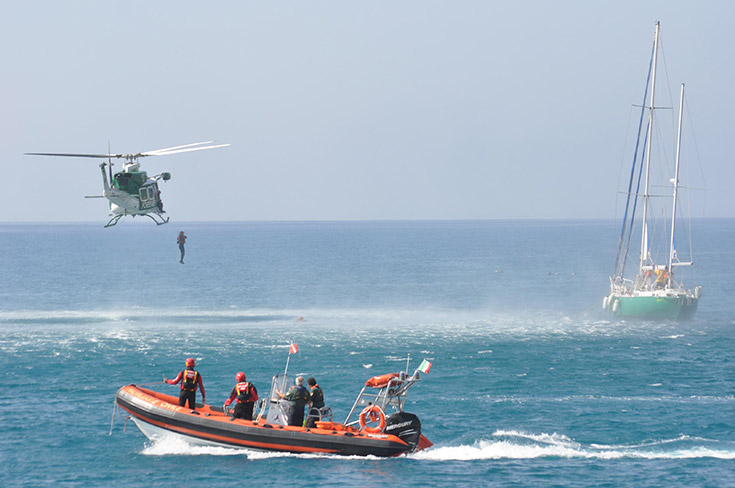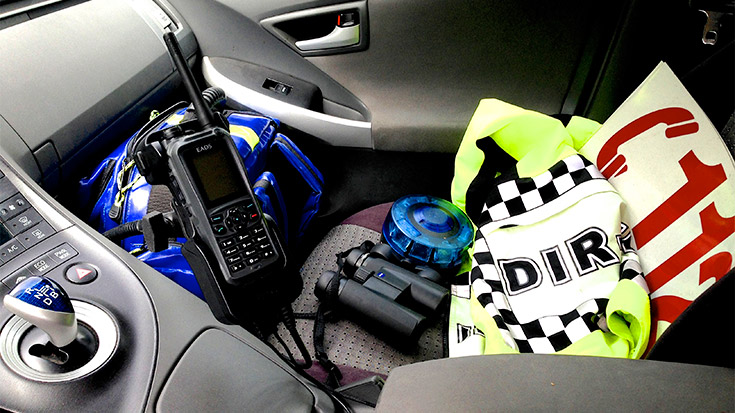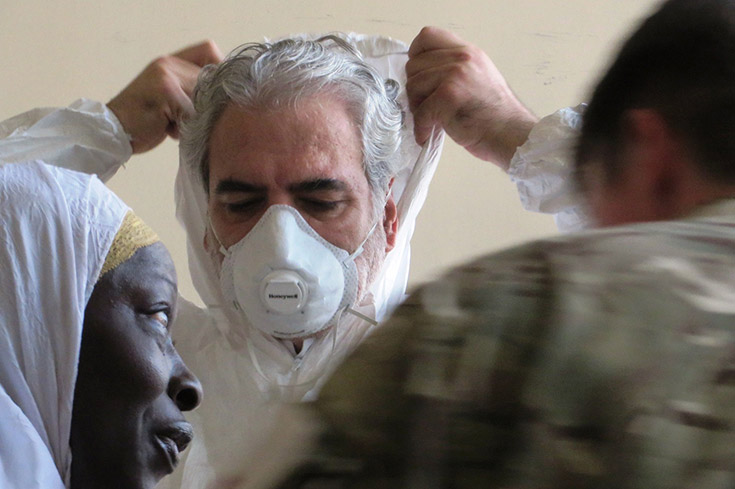CRJ September 2015 (11:1) out now
Crisis Response Journal 11:1 is now live. Here's a look at what's inside our biggest issue ever, or click here for article summaries.

One of the main themes of this issue is that of community resilience, as exemplified by these Gruppo Lucano volunteers pictured workign with the Italian Corpo Forestale during a drill. See below for details on Giuseppe Guarino's article (photo: Gruppo Lucano)
Comment: Crisis response and critical austerity
Allowing services, agencies and organisations to make savings cuts in isolation will leave us exposed and vulnerable when it comes to responding to future crises, argues new Advisory Panel Member Robert McAlister, who says that a holistic approach must be espoused.
Joining up the dots in the UK criminal justice system
Emily Hough speaks to Police and Crime Commissioner Matthew Ellis about cutting through bureaucracy, how austerity can force positive re-examination of systems, disjointed services together, and about bringing disjointed services together to improve service delivery to the public.
Crisis communications in action
Marc Lerchs tells Emily Hough about the challenges of organising communications during the recent Battle of Waterloo commemorations in Belgium. The events involved 80,000 visitors, 6,000 re-enactors, several hundred horses, a large number of firearms and three tonnes of gunpowder, as well as attendance by many pubic figures, such as Prince Charles and the Duchess of Cornwall from the UK, along with the monarchs of Luxembourg, the Netherlands and Belgium.

How were communications were handled during the massive Battle of Waterloo commemorations? Emily Hough speaks to Marc Lerchs (author photo)
Humanitarian solidarity in the EU
European Commissioner for Humanitarian Aid and Crisis Management, Christos Stylianides, gives Emily Hough his first impressions after his first year in this role.

Christos Stylianides (pictured above) is also the European Ebola Co-ordinator; he travelled to Guinea, Sierra Leone and Liberia to take stock of the situation, and to identify th eneeds, challenges and gaps in the response on the ground (EC / ECHO / Anouk Delafortrie)
Staying safe in hostile environments
Specialist insurer Battleface outlines what measures people should take when preparing to travel to volatile, dangerous or conflict-ridden areas, as well as what to do if they get into trouble.
Personnel safety in the Arctic
As large passenger vessels continue to operate more frequently and further north in the Arctic, the prospect of having to conduct mass rescue operations with limited search and rescue resources is increasing, says Callum Kelly of Polaris-ERT.

With more traffic in the Arctic, is it time to revise safety guidelines? (Polaris-ERT)
Mudflow disasters in Georgia
The rugged Devdoraki region in Georgia is prone to devastating mudflows caused by its many glaciers and topographical features. Here, the Emergency Management Agency of Georgia describes its disaster prevention measures, and response to recent catastrophic incidents
Heat wave lessons from India
Following the heat-related deaths of more than 2,500 people in India this summer, Satish Kumar Dogra calls for heat waves to be classified as ‘natural calamities’ in order to improve national response to such events.
Heat wave in Karachi
A week-long heat wave in June this year struck the province of Sindh in Pakistan with ferocity, reports Luavut Zahid, who questions whether the city is ready for another heat wave like the one it has just experienced
Emergency camp management
Vlatko Jovanovski of the Republic of Macedonia’s Protection and Rescue Directorate, describes the first ever EU exercise to look at setting up camps for people displaced by disasters or other events. Held in Macedonia, this exercise identified many lessons, not least that institutional memory is very weak among the key organisations that were involved in camp management during the Kosovo crisis, despite the Republic of Macedonia accommodating more than 340,000 refugees in its territory.
Cross-border co-operation
Christo Motz, who consulted to an EU programme on strengthening cross-border and inter-sector operability, reports his first impressions of a recent exercise on the Hungarian-Romanian border
Terrorist attacks in June
Lina Kolesnikova looks at the incidents in Tunisia and France, saying that authorities need to battle on several fronts, including the cognitive front, to undermine the appeal of radical ideologies.
British Red Cross response
BRC volunteers were among the first on the ground supporting people after the beach attacks in Tunisia, by sending out psychosocial teams
Live counter-terror exercise in London
Brian Dillon, Deputy Exercise Director, Metropolitan Police Service, London, UK describes how he and his team put together the largest live-play counter-terror operation London has ever seen – Exercise Strong Tower.

Exercise Strong Tower, which was based on a no-notice incident featuring armed gunmen across the capital, was played live in the streets of London (London Metropolitan Police)
Testing brigade procedures
Allen Perez, Deputy Assistant Commissioner, London Fire Brigade, says that Exercise Strong Tower provided London Fire Brigade with the perfect opportunity to test its response to large-scale events
Cyber incidents: The tip of the iceberg?
Data breaches – including the hacking of the Ashley Madison site – have dominated the news in the past few months. Here, Dr Dave Sloggett looks at how organisations should respond to data breaches.

Worse to come? Dr Dave Sloggett looks at data breaches and cybercrime (Lightspring / Shutterstock)
Deriving value from threat intelligence feeds
Threat intelligence feeds are key to an effective cybersecurity and risk management arsenal, says Christopher Morgan, co-founder and president of IKANOW, an information security analytics provider based in the US.
Communities and resilience – Mega-mall protection
Large shopping malls are cities and communities in themselves, according to Michael Kelly, who says that their operators should consider the initiatives taken by the Dubai Mall in order to protect their customers and stakeholders
Communities and resilience – Medically vulnerable populations
When a disaster strikes, medically vulnerable populations are at higher risk of injury and death than their non-vulnerable counterparts. These people need to be included in disaster planning, say Ian Portelli, Megan Mantaro and Andrew Guo
Public health and resilience
Raphael Barishansky and Audrey Mazurek outline the vital role public health plays in resilient communities, saying that public health should be on the list of planners and response agencies.
A bottom-up approach
Giuseppe Guarino of the Robert Mallett Foundation, describes an internationally-acclaimed project that builds resilience to disasters through a large network of small communities in a particularly strategic region of Italy, which has more than its share of natural hazards
Population preparedness
A recent study across Europe found a worrying lack of interest among the public about emergency preparedness, says Hara Caracostas, Crisis Management and Urban Security Policy Manager at the European Organisation for Security. What are the reasons for this and how can they be overcome?
Social vulnerability and governance
Dr Denise D P Thompson, Assistant Professor at the Department of Public Management, John Jay College of Criminal Justice in New York, and Member of CRJ’s Editorial Advisory Panel, compares the earthquakes in Haiti and Nepal, finding that despite the similar level of threat exposure, social and governance factors play a vital role in disaster impact and societal resilience.
City resilience
Sweden is pioneering a holistic resilience initiative, reports Magnus Qvant, General Secretary of the Resilient Cities Organisation, Sweden
Crowd response psychology
To ensure greater crowd safety in emergencies, society needs to overcome any fear of the crowd, and planners need to treat communities as genuine partners, not potential adversaries, contends Dr Chris Cocking, Senior Lecturer, School of Health Sciences at the University of Brighton in the UK.
Involving communities
Emergency response is not something you ‘do’ to communities, but something you do ‘with them’ explains Ian Wilson, Emergency Manager of North Somerset Council, UK.
Riding the storm
Garry Villeneuve, Director of Education at the Disaster Recovery Institute, describes steps government agencies should take in contingency planning.
Gender equality in civil contingencies Part II
“With almost chilling consistency, respondents outlined how, as a woman, that had been talked over or around at meetings chaired by male colleagues and, in some cases, ignored completely.” Advisory Panel Member, Urban Resilience Editor and Rhead Group’s lead for resilience planning and policy Andy Marshall, speaks to nine senior female figures in homeland security and civil contingencies to find out the female experience in this line of work.

A woman being too assertive can often be seen more negatively at a meeting than if a male colleague takes the same approach, the latter often being perceived as bold, decisive and strong – this is one of the findings of Andy Marshall's research into gender issues and civil contingencies (Jorgen McLeman / 123RF)
Treating PTSD in Israel’s Police
Jay Levinson, Mordechai Cohen and Avraham Domb describe how psychologists are assigned to follow and support those police units that experience the most extensive exposure to bombings in Israel.
PTSD and resilience in firefighters
Marc Ardon of the Zeeland Fire Service in the Netherlands presents research into getting a clearer picture of the prevalence of Post Traumatic Stress among firefighters, and to examine the possibility of an interrelationship between PTSD and personal resilience.
Advanced situational awareness Part III
In the third part of this series, Bukhtiar Mohsin – a senior scientist at the Pakistan Atomic Energy Commission – describes how an EU-funded project analyses data from Unmanned Aerial Vehicles, providing incident commanders with situational awareness and expert advice in disaster scenarios.
Legal liability in nuclear accidents Part I
Alina Alexe from the Ministry of Foreign Affairs in Romania, argues that the existing international nuclear liability framework cannot prevent large-scale nuclear disasters.
Effective decision-making records Part I
Maintaining clear records of decisions taken can be overlooked in the heat of an incident, says Advisory Panel Member Roger Gomm. But failing to keep proper records could put your credibility – and that of your organisation – on the line.
Landslide search and rescue Part III
Thomas J Richardson, Seattle Fire Department and FEMA US&R WA-TF1, concludes this three-part examination of the urban search and rescue response after the SR530 landslide in Washington State.
Crisis Response Journal at Milipol, Paris
Find out more details of the CRJ keynotes and panel debate, featuring CRJ Specialist Editors Andy Marshall and Ian Portelli, as well as Advisory Panel Member Lina Kolesnikova and Editor in Chief Emily Hough.
Looking back – Airport attacks in 1985
Simultaneous attacks on Rome and Vienna airports by the Abu Nidal Organisation 30 years ago left 16 people dead and more than 100 injured, writes Tony Moore
Europe - Flood scenario exercise
Per-Øyvind Semb, a Seconded National Expert for the European Commission within DG Humanitarian Aid and Civil Protection (ECHO), reports on a cross-border exercise held with partners in Croatia, with partners from Hungary, Austria and Slovenia
Frontline: A photographic humanitarian activist
Emily Hough speaks to Giles Duley, a documentary photographer and photojournalist who is working on a project to document the lasting effects of war around the world, years after the fighting has ended.
Subscribers receive a hard copy of the latest issue, tablet and online versions, as well as full access to CRJ's digital archive of content. More details here
Emily Hough, 07/09/2015